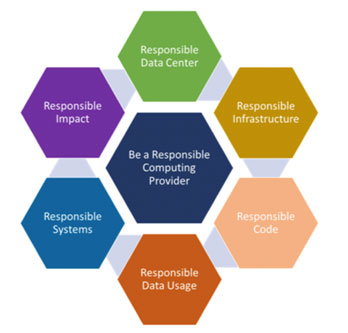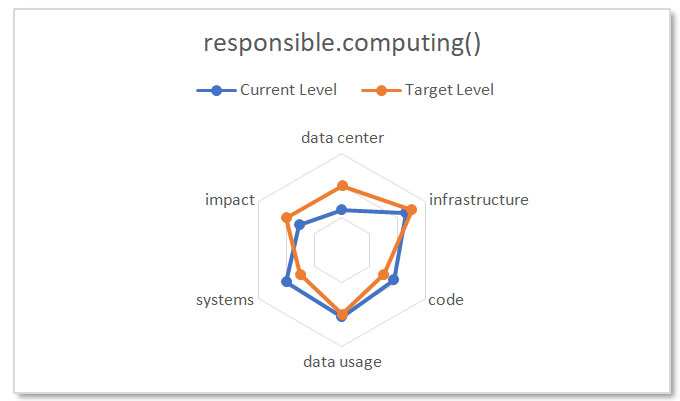Responsible computing provides the basis for evaluating how responsible organizations are in their use of IT, based on reporting requirements of environmental, social and governance (ESG) while including the effects of information technology against the United Nations’ sustainable development goals (SDGs).
There are six areas of interest:
- responsible data center,
- responsible infrastructure,
- responsible code,
- responsible data usage,
- responsible systems and
- responsible impact.
Data center, infrastructure and code are focused on industry collaboration on strategies for the IT community to use as part of their journey to reach net-zero emissions by 2050, as called for in the Paris Agreement.
Data usage, systems and impact are focused more on providing tools for the IT community to recognize and address ethical issues, increase trust and auditability, and reduce harm caused by technology.
They all interrelate, as shown in the diagram below. Each one feeds the others.

There is substantial interaction and dependence between the six areas, and they all include topics of environmental and social impact. Taking a holistic approach to decision making is a requirement of being a responsible-computing provider. Use cases within a particular domain should clearly show the interactions between the domains to avoid disjointed workstreams.
Some examples of interactions between them include:
- code runs on infrastructure,
- infrastructure is located within data centers (and elsewhere),
- data centers have a social and environmental impact where they are built,
- responsible data usage provides high-quality inputs for computing systems,
- irresponsible data usage can result in training biased computing system,
- unnecessary data usage results in increased infrastructure and data center requirements,
- biased computing systems can have a negative impact on individuals, society, and the environment.
All six areas share an underlying set of values and focus on ethics and sustainability. Together, they aim to create more responsible-computing providers by providing resources that educate, evaluate and guide IT organizations towards reducing their adverse impact on the planet and prioritizing computing for social good.
These values include:
- efficient use of available and future technology,
- data centers that are designed and operated with an emphasis on sustainability,
- conscious code choices that optimize environmental, social and economic impact,
- technologies and innovations that drive positive change for society at large,
- inclusive systems that address bias and discrimination driving equality for all and
- data that is securely used to drive transparency, fairness and respect for its users.
The principles provide a set of cross-cutting beliefs that underpin the values of a responsible computing provider.
- sustainability: contributing to the success of the UN SDGs and or ESG concerns,
- inclusivity: trustworthy, inclusive, respectful and ethical at every step—with the team and those impacted by the outcomes engaged,
- circularity: modularity, reusability and circular economy in eliminating waste,
- openness: transparent and open to share, consume and learn from the wider community,
- authenticity: being genuine and true to the values and principles to which you have been committed, be trusted, unbiased and collaborative and
- accountability: becoming a role model, doing what is right, driving decisions with positive impact through measurable goal-setting.
- Responsible Data Center
A responsible data center is one that reduces environmental impact with more efficient strategy and design. This implies that owners monitor energy consumption and their carbon footprint. Using cleaner energy by migrating to renewable energy sources will also help. On the “output” side, a responsible data center will optimize re-use of waste from cooling and production, such as using waste heat to grow algae. To comply with UN SDGs, we need to be net zero by 2030.How can this be achieved? By:- reducing energy consumption with accurate measurements,
- implementing renewable energy sources,
- identifying cooling considerations based on location and
- focusing on cooling, power, distribution, UPS service, generators, cables and racks with emphasis on use and re-use of materials.
The benefits of responsible data centers include increased operational efficiency and reduced energy consumption and costs. Environmentally responsible data centers decrease CO2 emissions and less reliance on rare metals and toxic materials reduce pollution.
- Responsible Infrastructure
Responsible infrastructure aims to realize greater efficiency with infrastructure designed to deliver high-performing sustainable operations. This can be achieved by consolidating workloads that peak at different times to complement each other and increase efficient use of resources. In turn, these high levels of utilization, improved by consolidation, deliver more efficient use of energy and resources. To achieve this, we must establish a baseline measurement on energy usage and material and asset lifecycles. We can then improve analysis and reporting based on experience and the established baseline. Each IT infrastructure vendor should provide information and reports on energy usage and product lifecycle.This can result in savings of physical space, reduced waste and energy consumption. It aids in managing the ESG impact of the hardware, software and networks required to develop, test, deliver, monitor, control and support IT services. Consolidation and rationalization enables individuals and organizations to have a positive impact on the world. - Responsible Code
Responsible code aligns teams on software architecture, technology, programming language and platform to anticipate, monitor and control the total costs of running, supporting and maintaining applications. They balance the trade-off between accuracy, speed and cost, including energy consumption of systems to address the hidden energy impact of code, reduce data duplication and improve cybersecurity.To achieve this, we must implement sustainability maturity assessment tools and KPIs to accelerate decision-making and pinpoint areas requiring more scrutiny during software development by using tools and methods to apply to develop applications more responsibly. Team awareness can be heightened by setting up on-going training and workshops to reinforce shared sustainability goals. Have you ever seen a request-for-proposal that set energy consumption limits?Conscious code choices reflect accessibility, energy consumption, economic sustainability and improved cybersecurity. By exposing the hidden energy impact of code, they increase awareness of the responsibility that comes with writing code and the impacts on users’ lives and the planet.
- Responsible Data Usage
Responsible data usage certifies that the data used is of high quality and the processes and people are trusted. Intelligent work flows help reduce errors and misinterpretation of data from manual handling. Quality data enables the application of artificial intelligence and machine learning to drive innovation.
|
Robust policies, guidelines and practices for the governance of data (e.g. maintaining lineage and explain ability) support ongoing risk-assessment and risk mitigation for incident response and data breach remediation. Accountable data-retention and destruction practices aid in managing the data life cycle.Minimal errors in the data reduce financial losses, incorrect executive decisions and reputation damage to the integrity of individuals, enterprises or even markets. Consideration of responsible data usage heightens collaboration between the business and IT. - Responsible Systems
Responsible systems ensure that systems employ an integrated set of technologies to provide a service to people. We should build systems that are ethical, privacy-preserving, secure and resilient, designed with the environment, individuals, society and the future in mind.Responsible systems can be viewed at three layers. First, we need a cultural ethos across the entire organization. This enables the use of forensic technology that can monitor, detect issues to enable trust. And last, we need governance requirements to which the organization adheres.Ongoing monitoring ensures companies develop and use responsible systems to help maintaining integrity of internal systems to achieve compliance with internal and external standards, reinforcing corporate social responsibility.
- Responsible Impact
Responsible impact aims to offset the impact around ESG to level the playing field through sustainability/circularity, diversity/inclusion, climate, openness and ethics.To measure maturity characteristics, we need:
- Responsible Data Center
- goal setting,
- scalability,
- replicability,
- socially responsible business model and strategy,
- metrics and
- traceability to the United Nations sustainability design goals.Measurement is key. To achieve this, we must implement sustainability maturity assessment tools and KPIs to accelerate decision-making and pinpoint areas requiring more scrutiny across all areas. A self-assessment tool would be great value here.

Responsible impact can improve operational efficiency, aid in compliance with legislation, governance standards and evolving cultural norms.
Conclusion
Responsible computing helps you meet sustainability goals so that your organization will become more operationally efficient and demonstrate ROI on those efforts, including:
- reduced power consumption,
- waste reduction for packaging,
- cost-effective heating and cooling solutions and
- supply chain accountability.
You can achieve milestones and measure your progress now and through 2030, so your organization will constantly evolve, and sustainability will become part of your organization’s DNA.
The Responsible Computing program is a program of Object Management Group with the mission to evaluate, educate and guide organizations through this journey.
https://responsiblecomputing.net
Copyright © 2022, Responsible Computing™, a program of Object Management Group, Inc. (“OMG®”). All other trademarks in this document are the properties of their respective owners.

















